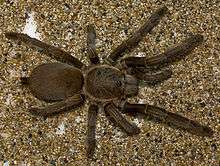Selenocosmia crassipes
| Selenocosmia crassipes | |
|---|---|
 | |
| Scientific classification | |
| Kingdom: | Animalia |
| Phylum: | Arthropoda |
| Class: | Arachnida |
| Order: | Araneae |
| Family: | Theraphosidae |
| Genus: | Selenocosmia |
| Species: | S. crassipes |
| Binomial name | |
| Selenocosmia crassipes (L. Koch, 1874) | |
| Synonyms | |
| |
Also known as "Queensland whistling tarantula" (or "barking spider") S. crassipes is a species of tarantula native to the east coast of Queensland, Australia. The name "whistling tarantula" comes from its ability to produce a hissing noise when provoked, a trait it shares with other Australian theraphosids.[1] This hissing is produced by the spider stridulating a patch of setae associated with its chelicerae. The species name crassipes is Latin for "fat leg" referring to the relatively fat front legs.
Selenocosmia crassipes can attain legspans of up to 22 cm (8.7 in). Its body length, from eyes to the rear of its abdomen, measures between 6 and 9 cm (2.4 and 3.5 in), making it the largest Australian tarantula.
This species is quite shy and normally does not wander far from its burrow.[2] Young spiders find natural burrows under rocks or roots. Adults expand their burrows up to 2 metres (6.6 ft) lined with silk with a tunnel off the main tunnel going upwards to a chamber with an air pocket sufficient to last a few days. The name Barking spider is inappropriate as this spider does not bark. Another common name "bird eating spider" is also false as this spider does not normally eat birds.
S. crassipes lives in rainforests and gullies or other sheltered cooler spots in open forests along the Queensland Central coast. Identification is relatively simple as this very large spider has thicker front legs than back legs.[1] Females live up to thirty years, males up to eight years.[3]
S. crassipes is a fast-growing spider and widely sought after as a pet. It is harvested from the wild, often illegally, a threat to its natural population. The current generic name Selenocosmia has been wrongly applied to the Australian species and will be revised, the generic name Phlogius being reinstated.[1]
References
- 1 2 3 "Tarantula or Whistling Spiders". Queensland Museum. Retrieved 23 March 2014.
- ↑ "Giant bird-eating spiders invade town". news.au. 6 May 2009. Retrieved 23 March 2014.
- ↑ "Tarantulas Spin Web Of Terror In Oz Town". Sky News. 20 May 2009. Retrieved 23 March 2014.
External links
- Norman I. Platnick (2011): The world spider catalog, version 12.0. American Museum of Natural History.
- Steve Nunn's Australian Tarantulas
- Queensland Museum